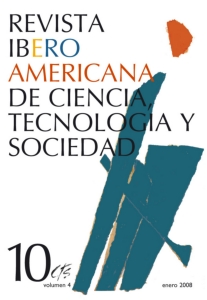An Exploratory Approach to Our Normative Language About Technical Artifacts
DOI:
https://doi.org/10.52712/issn.1850-0013-913Keywords:
technological artefact, proper technological functions, intrinsic evaluation, instrumental valuesAbstract
This paper explores the characteristics of the normative language we employ in technologically evaluating technological artefacts. Speaking in general terms, the intuition to be defended could be put as follows: the language we employ in evaluating technological artefacts involves the attribution of instrumental values, and the clue to interpret this normative field lies in the notion of utility or correct use of a technological artefact. This paper is organized in three parts. Firstly, a definition of technological artefact is presented. Besides, it is explored the intuition that our evaluative language concerning technological artefacts involves, basically, the proper technological functions of such artefacts. Secondly, the question of what it means to intrinsically evaluate the proper technological functions of an artefact is explored. Finally, the general traits of this process of evaluation are characterized.
Downloads
References
BUNGE, M. (1985): Treatise on Basic Philosophy, Vol. VII: Philosphy of Science and Technology. Part II: Life Science, Social Science and Technology, Dordrecht-Boston, Reidel.
DIPERT, R. R. (1995): "Some issues in the Theory of Artifacts: Defining 'Artifact' and Related Notions", The Monist, 78, pp. 119-35.
KROES, P. (2002): "Design methodology and the nature of technical artifacts", Design Studies, 23, pp. 287-302.
LATOUR, B. (1992): "Where Are the Missing Masses? The sociology of a Few Mundane Artifacts" en W. Bijker y J. Law (eds.): Shaping Technology/Building Society. Studies in Sociotechnical Change, Cambridge (MA), The MIT Press, pp. 225-258.
LAWLER, D. (2008), "La condición comunicativa de los artefactos técnicos", en D. Parente (ed.): Encrucijadas de la técnica: ensayos sobre tecnología, sociedad y valo-res, La Plata, EDULP-Universidad Nacional de La Plata (en prensa).
LAWLER, D. (2006): "La estructura de la acción técnica y la gramática de su compo-sición", Scientiae Studia, vol. 4, n. 3, pp. 393-420.
LAWLER, D. (2003): "Las funciones técnicas de los artefactos y su encuentro con el constructivismo social en tecnología", Revista Iberoamericana de Ciencia, Tecnología y Sociedad - CTS, nº1 vol. 1, pp. 27-71.
MAHNER, M. y M. BUNGE (2001): "Function and Functionalism: A Synthetic Perspective", Philosophy of Science, 68, pp. 75-94.
MAUD, B. (2000): "Proper Functions and Aristotelian Functions in Biology", Studies in History and Philosophy of Biology and Biomedical Sciences, 31/1, pp. 155-178.
NORMAN, D. (1990): La psicología de los objetos cotidianos, Madrid, Nerea.
QUINTANILLA, M. A. (1998): "Técnica y Cultura", Teorema, XVII/3, pp. 49-69.
QUINTANILLA, M. A. (1989): Tecnología. Un enfoque filosófico, Madrid, Fundesco.
ROSENMAN, M., y J. GERO (1998): "Purpose and function in design: from the socio-cultural to the technophysical", Design Studies, 19, pp. 161-186.
VEGA, J. (2007): Normatividad y artefactos, manuscrito.
WRIGHT, G. H. von (1963): The Varieties of Goodness, London, Routledge.
Downloads
Published
How to Cite
Issue
Section
License
Copyright (c) 2025 CC Attribution 4.0

This work is licensed under a Creative Commons Attribution 4.0 International License.
All CTS's issues and academic articles are under a CC-BY license.
Since 2007, CTS has provided open and free access to all its contents, including the complete archive of its quarterly edition and the different products presented in its electronic platform. This decision is based on the belief that offering free access to published materials helps to build a greater and better exchange of knowledge.
In turn, for the quarterly edition, CTS allows institutional and thematic repositories, as well as personal web pages, to self-archive articles in their post-print or editorial version, immediately after the publication of the final version of each issue and under the condition that a link to the original source will be incorporated into the self-archive.











